

Which of the following hormones is not secreted by the human placenta?
a. Prolactin
b. Progesterone
b. Oestrogen
c. Human chorionic gonadotropin
a) Prolactin
Explanation: Prolactin is a hormone produced by the pituitary gland. It stimulates breast development and milk production in women.
When is the World AIDS day celebrated?
a. 1st December
b. 3rd December
c. 4th December
d. 10th December
a) 1st December
Explanation: World AIDS Day is celebrated on 1st December every year since 1988.
Which antibody initiates allergic reactions in the body?
a. IgD
b. IgE
c. IgA
d. IgM
b) IgE
Explanation: Our immune system reacts to an allergen by producing antibodies known as Immunoglobulin E (IgE). These antibodies travel to cells that release chemicals, causing an allergic reaction.
Which cells secrete antibodies?
a. Monocytes
b. Lymphocytes
c. Neutrophils
d. Eosinophils
b) Lymphocytes
Explanation: Lymphocytes are one of the main types of immune cells. Lymphocytes are of two types namely B and T cells. B lymphocytes produce antibodies.
What will be the palindromic nucleotide sequence for below given fragment of DNA?
5’-GAATTC-3’
a. 3’-GAATTC-5’
b. 3’-GTTAAC-5’
c. 5’-GTTAAC-3’
d. 5’-CTTGAC-3’
b) 3’-GTTAAC-5’
Explanation: A palindromic sequence is a sequence of nucleic acids in a double stranded DNA and/or RNA wherein reading from 5' to 3' of one strand matches to 5' to 3' on the other complementary strand.
Total number of base pairs in DNA double helix is 2x109. In an experiment, DNA is treated with a compound X, which has a tendency to place itself amid the nitrogenous base pairs. It results in an increase in the distance between two consecutive bases from 0.34 nm to 0.44 nm. Find out the length of DNA double helix in the presence of saturating amount of the compound X.
a. 0.88x109 nm
b. 0.88x106 nm
c. 0.58x109 nm
d. 0.58x106 nm
a) 0.88x109 nm
Explanation: Increase in the distance between two consecutive bases=0.44 nm.
Total Base pairs in DNA double helix =2x109
The length of DNA double helix in the presence of saturating amount of the compound X=0.44 nm x 2x109 = 0.88 x109 nm
Which of the following is not an example of ex-situ conservation?
a. Biosphere reserves
b. Cryopreservation
c. Seed bank
d. Botanical garden
a) Biosphere reserves
Explanation: The conservation of plants and animals outside their natural habitat is known as ex-situ conservation. Biosphere reserve is an example of in-situ conservation.
Draw a schematic representation of binary fission in Amoeba.
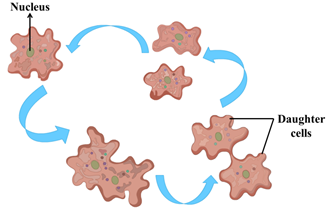
The advantages of micropropagation are as follows:
i. It facilitates the production of a large number of plants in a short duration.
ii. The plants produced through this technique are genetically identical.
An ideal contraceptive should possess following characteristics:
i. It should be user-friendly.
ii. It should be easily available.
iii. It should be effective with least side-effects.
iv.It should not interfere with sexual drive.
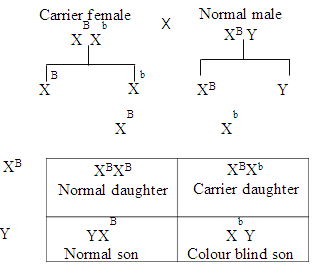
According to Chargaff’s rule, the DNA molecule should have an equal ratio of pyrimidine and purine. i.e.,
A=T and C=G
% A = % T
% G = % C
The given organism contains 18% of cytosine.
Then according to the law, it would have 18% of guanine.
Thus, percentage of G + C content = 36%
The remaining 64% represents both A + T molecule.
Identify P, Q, R and S in the given table.
| Crop | Variety | Disease resistance |
| Wheat | Himgiri | P |
| Cauliflower | Q | Blackrot and curl blight |
| R | Pusa Swarnim | White rust |
| Cowpea | Pusa Komal | S |
| Crop | Variety | Disease resistance |
| Wheat | Himgiri | Leaf rust |
| Cauliflower | Pusa Shubhra | Blackrot and curl blight |
| Brassica | Pusa Swarnim | White rust |
| Cowpea | Pusa Komal | Bacterial blight |
Agrobacterium tumefaciens is a pathogen of various dicot plants. It is able to deliver a piece of DNA known as “TDNA” to transform normal cells into tumour cells. This tumour-inducing (Ti) plasmid is used to deliver the gene of interest into a plant, where it multiplies.
The given image shows an ecological pyramid for a freshwater lake.
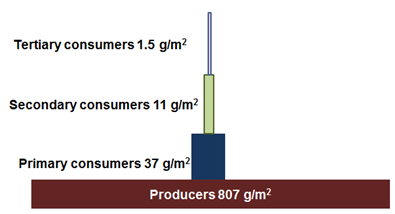
i. What type of pyramid is this?
ii. Why do pyramids like this often have three or four levels but seldom five?
i. This is a pyramid of biomass.
ii. The amount of energy reduces at each trophic level in an ecological pyramid. Due to which, they often have three or four levels but seldom five.
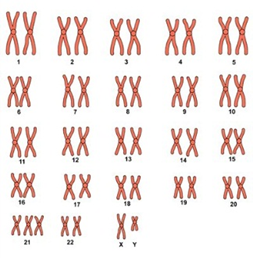
Karyotype: It refers to the standard arrangement of the chromosome complement prepared for chromosome analysis.
Humans possess 46 chromosomes in total, which are arranged into 23 pairs. In this image, trisomy of chromosome 21 is shown. It leads to Down's syndrome, which is also called trisomy 21. It is caused by the presence of three copies of chromosome 21.
a) Draw a schematic representation of the structure of a transcription unit and show the following in it:
i. Direction of transcription
ii. Polarity of the two strands
iii. Template strand
iv. Terminator gene
b) Mention the function of promoter gene in the transcription.
a)

b) Function of promoter gene:
The promoter gene is the region for binding of RNA polymerase. It acts by identifying and binding sites for RNA polymerase.
Inbreeding depression: Continued inbreeding especially close inbreeding reduces fertility and productivity. This is termed as inbreeding depression.
Following are the advantages of inbreeding:
i. It helps in the development of a pure line in any animal.
ii. It exposes harmful recessive genes which are eliminated by selection.
Differentiate between convergent and divergent evolution. Give one example of each.
| Convergent evolution | Divergent evolution |
| The process by which unrelated species become more similar in order to survive and adapt in similar environmental conditions | The process by which related species become less similar in order to survive and adapt in different environmental conditions |
| In this process different structures evolve in the same direction in different organisms | In this process same structures evolve in different directions in different organisms |
| For example, Potato and sweet potato | For example, Forelimbs of human, whale and bat |
Answer the following questions.
i. In a gene encoding a polypeptide of 40 amino acids, the 25th codon UAU is mutated to UAA. What can you interpret about its result?
ii. There are 100 amino acids. Estimate the number of proteins, which can be formed by triplet genetic code.
iii. The single stranded DNA of phage  x 174 contains 2400 nucleotides. If average protein contains 100 amino acids, then how many different proteins can be coded by this phage DNA?
x 174 contains 2400 nucleotides. If average protein contains 100 amino acids, then how many different proteins can be coded by this phage DNA?
i. UAA is the 'stop' codon. Thus, polypeptide chain will not grow after 24th amino acid so, rest of codons will not be able to translate in the absence of new initiating codon.
ii. The number of distinct proteins containing ‘n’ amino acids = 20n . Hence, total number of proteins in this case = 20100
iii. In DNA, 5400 nucleotides will form 2400/3=800 codons.
An average protein contains =100 amino acids
i.e. 100 codons form one protein
Therefore, 800/100=8 Proteins can be formed.
A virus-free healthy plant can be obtained from a diseased sugarcane plant through meristem culture. Although the plant is virus infected, the apical and axillary meristem is devoid of virus. In this technique, the meristem is removed from the plant and grown in-vitro by micropropagation. The medium rich in nutrients such as sucrose, vitamins and growth regulators like auxins, cytokinin is provided to the developing meristem.
A large number of virus-free plants are produced in a very short duration by employing this technique. These genetically identical new plants are called somaclones.
Bacillus thuringiensis is the source of Cry genes. CryIAc, CryIAb, and CryIIAb are isolated from Bacillus thuringiensis. These genes are beneficial for crops in the following ways:
Biodiversity refers to the diversity of biological organisation ranging from cellular macromolecules to biomes.
Genetic level: It refers to the diversity shown by a single species at genetic level. E.g., Mango
Specific level: It refers to the diversity at species level. E.g., amphibian species
Ecological levels: It refers to the diversity at ecosystem level. E.g., Estuaries
What are the two types of desirable approaches to conserve biodiversity? Explain with examples.
i. In-situ conservation
ii. Ex-situ conservation
iii. In-situ conservation: It refers to maintaining species of wild animals and plants in their natural habitats. The examples of In-situ conservation include national parks and biosphere reserves.
iv. Ex-situ conservation: It refers to maintaining species and population diversity outside the natural habitats. The examples of ex-situ conservation include seed banks, botanical gardens, zoological gardens, aquaria etc.
Recombinant DNA technology involves following steps:
Answer the following questions.
i. Where does spermatogenesis occur in human testis?
ii. Give flow-chart of the process of spermatogenesis up to the formation of spermatozoa.
iii. Trace the path of spermatozoa from the testis up to the ejaculatory duct.
i. Spermatogenesis occurs in seminiferous tubules in human testis.
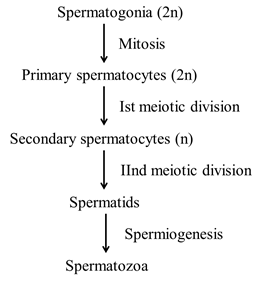
iii. Path of spermatozoa:
Sewage treatment uses microorganisms to digest the waste matter. Answer the following questions regarding the sewage treatment.
i. Suggest the role of microorganisms in the aerobic digestion tank.
ii. Why chlorine is added into the water before it leaves the sewage treatment plant?
iii. Enlist the steps of sewage treatment in the form of flow-chart.
i. In the aerobic digestion tank, microorganisms such as bacteria and fungi convert organic compounds to simple inorganic forms.
ii. Chlorine is commonly used as a disinfectant in most sewage treatment plants. It is used to sterilise the treated sewage before it is discharged out from the treatment plant. It kills microorganisms during water treatment and thus, maintains the quality of the water.
iii. Following are the steps of sewage treatment:
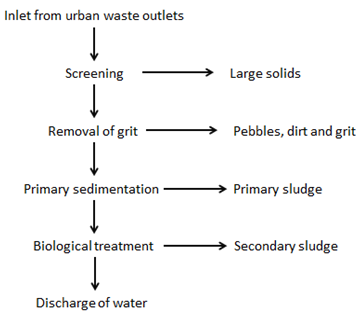
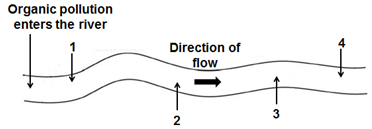
When untreated sewage is added into the water body, the nutrients present in it, dissolve into the water. Untreated sewage contains nitrates and phosphates, which allow the microscopic flora in water bodies to grow very rapidly. It results in a serious oxygen shortage in the water. Thus, the concentration of oxygen decreases in the water.
In the given image:
At point 1: BOD is high due to the respiration carried out by certain bacteria and fungi that feed on organic matter.
At point 2: BOD is less than at the point of entry of the pollutants. It is because, by this point, the amount of organic matter has decreased due to dispersal and break-down.
At point 3: BOD is just above normal. It is because pollutants are now much reduced.
At point 4: BOD back at normal point as all organic matter has been broken down.
In shorthorn cattle, the genotype RR causes a red coat, the genotype rr causes a white coat and the genotype Rr causes a roan coat. A breeder has red, white and roan cows and bulls. What phenotypes might be expected from the following mating and in what proportions?
(a) red X red
(b) red X roan
(c) red X white
(a) Parent: RR X RR
(Red coat) (Red coat)
Gamete: R R
| Progeny: | R | R |
| R | RR Red coat | RR Red coat |
| R | RR Red coat | RR Red coat |
Hence, all (100%) the offspring will bear red coat as both the parents are homozygous for the dominant allele (RR).
(b) Parent: RR X Rr
(Red coat) (Roan coat)
Gamete: R R, r
| Progeny: | R | r |
| R | RR Red coat | Rr Roan coat |
| R | RR Red coat | Rr Roan coat |
Hence, half (50%) of the offspring will bear red coat and the other half will bear roan coat, as one of the parents is homozygous for the dominant allele (RR) and other one is heterozygous for the trait (Rr).
(c) Parent: RR X rr
(Red coat) (White coat)
Gamete: R r
| Progeny: | r | r |
| R | Rr Roan coat | Rr Roan coat |
| R | Rr Roan coat | Rr Roan coat |
Hence, all (100%) the offspring will bear roan coat, as one of the parents is homozygous for the dominant allele (RR) and the other one is homozygous for the recessive allele (rr).
An operon is a part of DNA which functions as a gene regulatory unit in the process of transcription.
If lactose is withdrawn from the culture medium the operon is not expressed. The repressor combines with the operator gene and turns it off. Due to this, structural genes are inactivated and protein synthesis or transcription stops.
a) What is plant breeding? List the two steps the classical plant breeding involves. Mention any two limitations of traditional breeding technique.
b) What is biofortification? Give example.
a) Plant breeding refers to the purposeful manipulation of plant species to create desired plants that are better suited for cultivation, give better yields and are disease resistant. Classical plant breeding involves following two steps:
Following are the limitations of traditional breeding technique:
b) Biofortification refers to breeding crops with higher levels of vitamins, minerals, fats or proteins to improve public health. For example, wheat variety Atlas 66 possesses high protein content and has been used as a donor for improving the quality of wheat.
Following events occur in human body to cause immunodeficiency when HIV gains entry into the body:
Answer the following questions.
The below given table shows the results of an investigation, carried out at five different places (A, B, C, D and E) along a river.
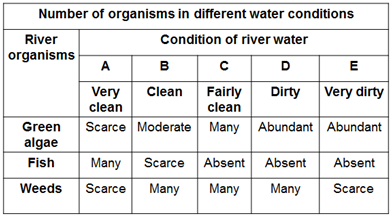
Give the reason for the relationship between:
a. The number of green algae and the condition of the river water
b. The number of fish and the condition of the river water
a) When untreated sewage and artificial fertilisers are added into the river water, the nutrients present in it, dissolve into the water. It causes an increase in the growth of green algae. In this table, green algae are showing their abundance at the points D and E. While, at the point “A”, it is scarce due to very clean water.
b) Growth of green algae in the river water, results in an increase in bacterial growth along with a decrease in the oxygen concentration in the water. It leads to the death of aquatic animals. This is the reason behind the total absence of fish at points, “C”, “D” and “E”. While, at the point “A”, there are many fish present in the river due to clean water.
Lynx prey on snowshoe hare. Hare provide over 70 % of the lynx diet. Thus, the population growth curve of the lynx and snowshoe hare show similarity with each other. The change in population of Lynx and snowshoe hare over time is given in the following table. Study it carefully and answer the below mentioned questions.
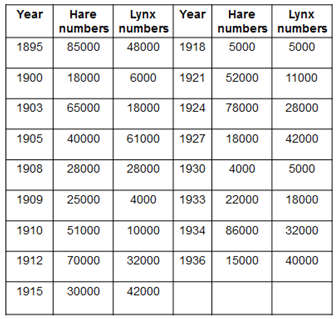
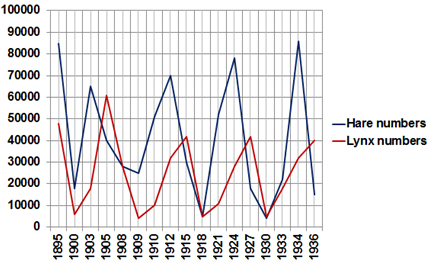
ii. Lynx is the predator and snowshoe hare is the prey.
iii. When hares are abundant, lynx populations expand.
iv. When lynx are abundant, hare populations decline.
v. The factors, which may be responsible for the unusual number of hare in the year 1895 include exposure to stress, whether in the form of predation, disease or scarcity of food.

Take your CBSE board preparation to another level with AI based and rich media animation on Extramarks - The Learning App.
Features of Learning App